Solid-State Cold Spray Additive Manufacturing of Ni-Based Superalloys: Processing–Microstructure–Property Relationships
Abstract
1. Introduction
2. Structural and Microstructural Evolution

3. Structure–Property Relationships
Mechanical Properties
4. Tribological Properties
5. Summary and Future Outlook
Author Contributions
Funding
Institutional Review Board Statement
Informed Consent Statement
Data Availability Statement
Conflicts of Interest
References
- Sova, A.; Grigoriev, S.; Okunkova, A.; Smurov, I. Potential of Cold Gas Dynamic Spray as Additive Manufacturing Technology. Int. J. Adv. Manuf. Technol. 2013, 69, 2269–2278. [Google Scholar] [CrossRef]
- Ralls, A.M.; John, M.; Noud, J.; Lopez, J.; LeSourd, K.; Napier, I.; Hallas, N.; Menezes, P.L. Tribological, Corrosion, and Mechanical Properties of Selective Laser Melted Steel. Metals 2022, 12, 1732. [Google Scholar] [CrossRef]
- Thomas, D. Costs, Benefits, and Adoption of Additive Manufacturing: A Supply Chain Perspective. Int. J. Adv. Manuf. Technol. 2016, 85, 1857–1876. [Google Scholar] [CrossRef]
- Frazier, W.E. Metal Additive Manufacturing: A Review. J. Mater. Eng. Perform. 2014, 23, 1917–1928. [Google Scholar] [CrossRef]
- Ralls, A.M.; Kumar, P.; Menezes, P.L. Tribological Properties of Additive Manufactured Materials for Energy Applications: A Review. Processes 2021, 9, 31. [Google Scholar] [CrossRef]
- Pereira, T.; Kennedy, J.V.; Potgieter, J. A Comparison of Traditional Manufacturing vs Additive Manufacturing, the Best Method for the Job. Procedia Manuf. 2019, 30, 11–18. [Google Scholar] [CrossRef]
- Kruth, J.P.; Wang, X.; Laoui, T.; Froyen, L. Lasers and Materials in Selective Laser Sintering. Assem. Autom. 2003, 23, 357–371. [Google Scholar] [CrossRef]
- Vorkapić, M.; Mladenović, I.; Pergal, M.; Ivanov, T.; Baltić, M. Optimisation of Tensile Stress of Poly(Lactic Acid) 3D Printed Materials Using Response Surface Methodology. Tribol. Mater. 2022, 1, 70–80. [Google Scholar] [CrossRef]
- Gibson, I.; Rosen, D.; Stucker, B. Directed Energy Deposition Processes. In Additive Manufacturing Technologies: 3D Printing, Rapid Prototyping, and Direct Digital Manufacturing; Gibson, I., Rosen, D., Stucker, B., Eds.; Springer: New York, NY, USA, 2015; pp. 245–268. ISBN 978-1-4939-2113-3. [Google Scholar]
- Ralls, A.M.; Kasar, A.K.; Menezes, P.L. Friction Stir Processing on the Tribological, Corrosion, and Erosion Properties of Steel: A Review. J. Manuf. Mater. Process. 2021, 5, 97. [Google Scholar] [CrossRef]
- Ralls, A.; Kumar, P.; Misra, M.; Menezes, P.L. Material Design and Surface Engineering for Bio-Implants. JOM 2020, 72, 684–696. [Google Scholar] [CrossRef]
- Braun, T.M.; Schwartz, D.T. The Emerging Role of Electrodeposition in Additive Manufacturing. Electrochem. Soc. Interface 2016, 25, 69. [Google Scholar] [CrossRef]
- Daryadel, S.; Behroozfar, A.; Minary-Jolandan, M. Toward Control of Microstructure in Microscale Additive Manufacturing of Copper Using Localized Electrodeposition. Adv. Eng. Mater. 2019, 21, 1800946. [Google Scholar] [CrossRef]
- Atzeni, E.; Salmi, A. Economics of Additive Manufacturing for End-Usable Metal Parts. Int. J. Adv. Manuf. Technol. 2012, 62, 1147–1155. [Google Scholar] [CrossRef]
- Watson, J.K.; Taminger, K.M.B. A Decision-Support Model for Selecting Additive Manufacturing versus Subtractive Manufacturing Based on Energy Consumption. J. Clean. Prod. 2018, 176, 1316–1322. [Google Scholar] [CrossRef]
- Tofail, S.A.M.; Koumoulos, E.P.; Bandyopadhyay, A.; Bose, S.; O’Donoghue, L.; Charitidis, C. Additive Manufacturing: Scientific and Technological Challenges, Market Uptake and Opportunities. Mater. Today 2018, 21, 22–37. [Google Scholar] [CrossRef]
- Abdulhameed, O.; Al-Ahmari, A.; Ameen, W.; Mian, S.H. Additive Manufacturing: Challenges, Trends, and Applications. Adv. Mech. Eng. 2019, 11, 1687814018822880. [Google Scholar] [CrossRef]
- Scott, J.; Gupta, N.; Weber, C.; Newsome, S.; Wohlers, T.; Associates, W.; Caffrey, T.; Associates, W. Additive Manufacturing: Status and Opportunities. 35p. Available online: https://cgsr.llnl.gov/content/assets/docs/IDA_AdditiveM3D_33012_Final.pdf (accessed on 21 February 2012).
- Bourell, D.; Kruth, J.P.; Leu, M.; Levy, G.; Rosen, D.; Beese, A.M.; Clare, A. Materials for Additive Manufacturing. CIRP Ann. 2017, 66, 659–681. [Google Scholar] [CrossRef]
- Graybill, B.; Li, M.; Malawey, D.; Ma, C.; Orozco, J.; Franco, E. Additive Manufacturing of Nickel-Based Superalloys. In Proceedings of the ASME 2018 13th International Manufacturing Science and Engineering Conference, College Station, TX, USA, 18–22 June 2018. [Google Scholar]
- Zapirain, F.; Zubiri, F.; Garciandía, F.; Tolosa, I.; Chueca, S.; Goiria, A. Development of Laser Welding of Ni Based Superalloys for Aeronautic Engine Applications (Experimental Process and Obtained Properties). Phys. Procedia 2011, 12, 105–112. [Google Scholar] [CrossRef]
- Park, S.-J.; Seo, S.-M.; Yoo, Y.-S.; Jeong, H.-W.; Jang, H. Effects of Al and Ta on the High Temperature Oxidation of Ni-Based Superalloys. Corros. Sci. 2015, 90, 305–312. [Google Scholar] [CrossRef]
- Cruchley, S.; Evans, H.; Taylor, M. An Overview of the Oxidation of Ni-Based Superalloys for Turbine Disc Applications: Surface Condition, Applied Load and Mechanical Performance. Mater. High. Temp. 2016, 33, 465–475. [Google Scholar] [CrossRef]
- Sanchez, S.; Smith, P.; Xu, Z.; Gaspard, G.; Hyde, C.J.; Wits, W.W.; Ashcroft, I.A.; Chen, H.; Clare, A.T. Powder Bed Fusion of Nickel-Based Superalloys: A Review. Int. J. Mach. Tools Manuf. 2021, 165, 103729. [Google Scholar] [CrossRef]
- Davis, J.R. Nickel, Cobalt, and Their Alloys; ASM International: Almere, The Netherlands, 2000; ISBN 978-0-87170-685-0. [Google Scholar]
- Mohon, L. NASA Advances Additive Manufacturing for Rocket Propulsion. Available online: http://www.nasa.gov/centers/marshall/news/nasa-advances-additive-manufacturing-for-rocket-propulsion.html (accessed on 21 February 2023).
- Wilson, L.G.; Ellis, D.L.; Carter, J.L.W. Additive Manufacturing of Oxide Dispersion Strengthened (ODS) Nickel-Based Superalloys. 2019. Available online: https://ntrs.nasa.gov/citations/20200002197 (accessed on 21 February 2019).
- Katsarelis, C.; Chen, P.; Gradl, P.; Protz, C.; Jones, Z.; Ellis, D.; Evans, L. Additive Manufacturing of NASA HR-1 Material for Liquid Rocket Engine Component Applications, Tampa, FL, 9 December 2019. Available online: https://ntrs.nasa.gov/citations/20200001007 (accessed on 21 February 2019).
- Albright, B. NASA Tests More Printed Rocket Engine Parts. Available online: https://www.digitalengineering247.com/article/nasa-tests-more-printed-rocket-engine-parts (accessed on 21 February 2023).
- Mrdak, M.R.; Vencl, A.; Nedeljkovic, B.D.; Stanković, M. Influence of Plasma Spraying Parameters on Properties of Thermal Barrier Coatings. Mater. Sci. Technol. 2013, 29, 559–567. [Google Scholar] [CrossRef]
- Sanviemvongsak, T.; Monceau, D.; Macquaire, B. High Temperature Oxidation of IN 718 Manufactured by Laser Beam Melting and Electron Beam Melting: Effect of Surface Topography. Corros. Sci. 2018, 141, 127–145. [Google Scholar] [CrossRef]
- Nie, J.; Chen, C.; Liu, L.; Wang, X.; Zhao, R.; Shuai, S.; Wang, J.; Ren, Z. Effect of Substrate Cooling on the Epitaxial Growth of Ni-Based Single-Crystal Superalloy Fabricated by Direct Energy Deposition. J. Mater. Sci. Technol. 2021, 62, 148–161. [Google Scholar] [CrossRef]
- Lu, N.; Lei, Z.; Hu, K.; Yu, X.; Li, P.; Bi, J.; Wu, S.; Chen, Y. Hot Cracking Behavior and Mechanism of a Third-Generation Ni-Based Single-Crystal Superalloy during Directed Energy Deposition. Addit. Manuf. 2020, 34, 101228. [Google Scholar] [CrossRef]
- Forsblom, M.; Grimvall, G. How Superheated Crystals Melt. Nat. Mater. 2005, 4, 388–390. [Google Scholar] [CrossRef] [PubMed]
- Leung, C.L.A.; Marussi, S.; Towrie, M.; del Val Garcia, J.; Atwood, R.C.; Bodey, A.J.; Jones, J.R.; Withers, P.J.; Lee, P.D. Laser-Matter Interactions in Additive Manufacturing of Stainless Steel SS316L and 13-93 Bioactive Glass Revealed by in Situ X-Ray Imaging. Addit. Manuf. 2018, 24, 647–657. [Google Scholar] [CrossRef]
- Fu, Y.; Loredo, A.; Martin, B.; Vannes, A.B. A Theoretical Model for Laser and Powder Particles Interaction during Laser Cladding. J. Mater. Process. Technol. 2002, 128, 106–112. [Google Scholar] [CrossRef]
- Zhang, Y.; Wu, L.; Guo, X.; Kane, S.; Deng, Y.; Jung, Y.-G.; Lee, J.-H.; Zhang, J. Additive Manufacturing of Metallic Materials: A Review. J. Mater. Eng. Perform. 2018, 27, 1–13. [Google Scholar] [CrossRef]
- Sadeghi, E.; Markocsan, N.; Joshi, S. Advances in Corrosion-Resistant Thermal Spray Coatings for Renewable Energy Power Plants. Part I: Effect of Composition and Microstructure. J. Therm. Spray Technol. 2019, 28, 1749–1788. [Google Scholar] [CrossRef]
- Kim, F.; Moylan, S. Literature Review of Metal Additive Manufacturing Defects. Available online: https://www.semanticscholar.org/paper/Literature-Review-of-Metal-Additive-Manufacturing-Kim-Moylan/9d5a4bf86b5c2b1967ab6469aa5f2143b6b9c6a7 (accessed on 21 February 2023).
- Wu, J.; Zhang, S.D.; Sun, W.H.; Wang, J.Q. Influence of Oxidation Related Structural Defects on Localized Corrosion in HVAF-Sprayed Fe-Based Metallic Coatings. Surf. Coat. Technol. 2018, 335, 205–218. [Google Scholar] [CrossRef]
- Prashar, G.; Vasudev, H. A Review on the Influence of Process Parameters and Heat Treatment on the Corrosion Performance of Ni-Based Thermal Spray Coatings. Surf. Rev. Lett. 2022, 29, 2230001. [Google Scholar] [CrossRef]
- Vencl, A. Optimization of the Deposition Parameters of Thick Atmospheric Plasma Spray Coatings. J. Balk. Tribol. Assoc. 2012, 18, 405. [Google Scholar]
- Lugscheider, E.; Barimani, C.; Eckert, P.; Eritt, U. Modeling of the APS Plasma Spray Process. Comput. Mater. Sci. 1996, 7, 109–114. [Google Scholar] [CrossRef]
- Daroonparvar, M.; Yajid, M.A.; Yusof, N.M.; Bakhsheshi-Rad, H.R.; Valefi, Z.; Hamzah, E. Effect of Y2O3 stabilized ZrO2 coating with tri-model structure on bi-layered thermally grown oxide evolution in nano thermal barrier coating systems at elevated temperatures. J. Rare Earths 2014, 32, 57–77. Available online: https://www.sciencedirect.com/science/article/abs/pii/S100207211460034X (accessed on 21 February 2023). [CrossRef]
- Daroonparvar, M.; Azizi Mat Yajid, M.; Yusof, N.M.; Sakhawat Hussain, M. Improved thermally grown oxide scale in air plasma sprayed NiCrAlY/Nano-YSZ coatings. J. Nanomater. 2013, 2013, 520104. Available online: https://www.hindawi.com/journals/jnm/2013/520104/ (accessed on 21 February 2023). [CrossRef]
- Henderson, M.B.; Arrell, D.; Larsson, R.; Heobel, M.; Marchant, G. Nickel Based Superalloy Welding Practices for Industrial Gas Turbine Applications. Sci. Technol. Weld. Join. 2004, 9, 13–21. [Google Scholar] [CrossRef]
- Smith, M.F. 3—Comparing Cold Spray with Thermal Spray Coating Technologies. In The Cold Spray. Materials Deposition Process; Champagne, V.K., Ed.; Woodhead Publishing Series in Metals and Surface Engineering; Woodhead Publishing: Sawston, UK, 2007; pp. 43–61. ISBN 978-1-84569-181-3. [Google Scholar]
- Santini, C. Particle Injection Simulation on Cold Spray Technology. Master’s Thesis, South Dakota State University, Brookings, SD, USA, 2020. [Google Scholar]
- Gärtner, F.; Stoltenhoff, T.; Schmidt, T.; Kreye, H. The Cold Spray Process and Its Potential for Industrial Applications. J. Therm. Spray Technol. 2006, 15, 223–232. [Google Scholar] [CrossRef]
- Li, W.-Y.; Gao, W. Some Aspects on 3D Numerical Modeling of High Velocity Impact of Particles in Cold Spraying by Explicit Finite Element Analysis. Appl. Surf. Sci. 2009, 255, 7878–7892. [Google Scholar] [CrossRef]
- Ichikawa, Y.; Tokoro, R.; Tanno, M.; Ogawa, K. Elucidation of Cold-Spray Deposition Mechanism by Auger Electron Spectroscopic Evaluation of Bonding Interface Oxide Film. Acta Mater. 2019, 164, 39–49. [Google Scholar] [CrossRef]
- Walker, M. Microstructure and Bonding Mechanisms in Cold Spray Coatings. Mater. Sci. Technol. 2018, 34, 2057–2077. [Google Scholar] [CrossRef]
- Karthikeyan, J. 4—The Advantages and Disadvantages of the Cold Spray Coating Process. In The Cold Spray. Materials Deposition Process; Champagne, V.K., Ed.; Woodhead Publishing Series in Metals and Surface Engineering; Woodhead Publishing: Sawston, UK, 2007; pp. 62–71. ISBN 978-1-84569-181-3. [Google Scholar]
- Zou, Y. Cold Spray Additive Manufacturing: Microstructure Evolution and Bonding Features. Acc. Mater. Res. 2021, 2, 1071–1081. [Google Scholar] [CrossRef]
- Jafari, D.; Vaneker, T.H.J.; Gibson, I. Wire and Arc Additive Manufacturing: Opportunities and Challenges to Control the Quality and Accuracy of Manufactured Parts. Mater. Des. 2021, 202, 109471. [Google Scholar] [CrossRef]
- Ahmad, B.; Zhang, X.; Guo, H.; Fitzpatrick, M.E.; Neto, L.M.S.C.; Williams, S. Influence of Deposition Strategies on Residual Stress in Wire + Arc Additive Manufactured Titanium Ti-6Al-4V. Metals 2022, 12, 253. [Google Scholar] [CrossRef]
- Williams, S.W.; Martina, F.; Addison, A.C.; Ding, J.; Pardal, G.; Colegrove, P. Wire + Arc Additive Manufacturing. Mater. Sci. Technol. 2016, 32, 641–647. [Google Scholar] [CrossRef]
- Gibson, I.; Rosen, D.; Stucker, B. Additive Manufacturing Technologies: 3D Printing, Rapid Prototyping, and Direct Digital Manufacturing; Springer: New York, NY, USA, 2015; ISBN 978-1-4939-2113-3. [Google Scholar]
- Rubino, F.; Astarita, A.; Carlone, P.; Genna, S.; Leone, C.; Minutolo, F.M.C.; Squillace, A. Selective Laser Post-Treatment on Titanium Cold Spray Coatings. Mater. Manuf. Process. 2015, 31, 1500–1506. [Google Scholar]
- Srikanth, A.; Mohammed Thalib Basha, G.; Venkateshwarlu, B. A Brief Review on Cold Spray Coating Process. Mater. Today Proc. 2020, 22, 1390–1397. [Google Scholar] [CrossRef]
- Shrestha, D.; Azarmi, F.; Tangpong, X.W. Effect of Heat Treatment on Residual Stress of Cold Sprayed Nickel-Based Superalloys. J. Therm. Spray Technol. 2022, 31, 197–205. [Google Scholar] [CrossRef]
- He, L.; Hassani, M. A Review of the Mechanical and Tribological Behavior of Cold Spray Metal Matrix Composites. J. Therm. Spray Technol. 2020, 29, 1565–1608. [Google Scholar] [CrossRef]
- Zhizhong, W.; Chao, H.; Huang, G.; Bin, H.; Bin, H. Cold Spray Micro-Defects and Post-Treatment Technologies: A Review. Rapid Prototyp. J. 2021, 28, 330–357. [Google Scholar] [CrossRef]
- Ralls, A.; Mao, B.; Menezes, P. Tribological Performance of Laser Shock Peened Cold Spray Additive Manufactured 316L Stainless Steel. J. Tribol. 2023, 1–28. [Google Scholar] [CrossRef]
- Chaudhuri, A.; Raghupathy, Y.; Srinivasan, D.; Suwas, S.; Srivastava, C. Microstructural Evolution of Cold-Sprayed Inconel 625 Superalloy Coatings on Low Alloy Steel Substrate. Acta Mater. 2017, 129, 11–25. [Google Scholar] [CrossRef]
- Cavaliere, P.; Silvello, A.; Cinca, N.; Canales, H.; Dosta, S.; Garcia Cano, I.; Guilemany, J.M. Microstructural and Fatigue Behavior of Cold Sprayed Ni-Based Superalloys Coatings. Surf. Coat. Technol. 2017, 324, 390–402. [Google Scholar] [CrossRef]
- AMS7057 (WIP) Cold Spray Additive Manufacturing (CSAM) Process—SAE International. Available online: https://www.sae.org/standards/content/ams7057/ (accessed on 21 February 2023).
- Tan, A.W.-Y.; Tham, N.Y.S.; Chua, Y.S.; Wu, K.; Sun, W.; Liu, E.; Tan, S.C.; Zhou, W. Cold Spray of Nickel-Based Alloy Coating on Cast Iron for Restoration and Surface Enhancement. Coatings 2022, 12, 765. [Google Scholar] [CrossRef]
- Sun, W.; Chu, X.; Lan, H.; Huang, R.; Huang, J.; Xie, Y.; Huang, J.; Huang, G. Current Implementation Status of Cold Spray Technology: A Short Review. J. Therm. Spray Technol. 2022, 31, 848–865. [Google Scholar] [CrossRef]
- Nikbakht, R.; Saadati, M.; Assadi, H.; Jahani, K.; Jodoin, B. Dynamic Microstructure Evolution in Cold Sprayed NiTi Composite Coatings. Surf. Coat. Technol. 2021, 421, 127456. [Google Scholar] [CrossRef]
- Devi, G.N.; Kumar, S.; Balaji, T.S.; Mangalarapu, T.B.; Chandrasekhar, S.B.; Gopal, A.V.; Jyothirmayi, A. Influence of Inter-Splat Bonding State of Cold Sprayed IN625 and IN718 Coatings on Mechanical and Corrosion Performance. Surf. Coat. Technol. 2022, 445, 128731. [Google Scholar] [CrossRef]
- Hu, Y.L.; Lin, X.; Li, Y.L.; Zhang, S.Y.; Gao, X.H.; Liu, F.G.; Li, X.; Huang, W.D. Plastic Deformation Behavior and Dynamic Recrystallization of Inconel 625 Superalloy Fabricated by Directed Energy Deposition. Mater. Des. 2020, 186, 108359. [Google Scholar] [CrossRef]
- Huang, K.; Logé, R.E. A Review of Dynamic Recrystallization Phenomena in Metallic Materials. Mater. Des. 2016, 111, 548–574. [Google Scholar] [CrossRef]
- Borchers, C.; Gärtner, F.; Stoltenhoff, T.; Kreye, H. Microstructural Bonding Features of Cold Sprayed Face Centered Cubic Metals. J. Appl. Phys. 2004, 96, 4288. [Google Scholar] [CrossRef]
- Wu, K.; Sun, W.; Tan, A.W.-Y.; Marinescu, I.; Liu, E.; Zhou, W. An Investigation into Microstructure, Tribological and Mechanical Properties of Cold Sprayed Inconel 625 Coatings. Surf. Coat. Technol. 2021, 424, 127660. [Google Scholar] [CrossRef]
- Marple, B.R. Thermal Spray 2006: Building 100 Years of Success; ASM International: Almere, The Netherlands, 2006; ISBN 978-1-61503-121-4. [Google Scholar]
- Sun, W.; Tan, A.W.Y.; Bhowmik, A.; Marinescu, I.; Song, X.; Zhai, W.; Li, F.; Liu, E. Deposition Characteristics of Cold Sprayed Inconel 718 Particles on Inconel 718 Substrates with Different Surface Conditions. Mater. Sci. Eng. A 2018, 720, 75–84. [Google Scholar] [CrossRef]
- Ma, W.; Xie, Y.; Chen, C.; Fukanuma, H.; Wang, J.; Ren, Z.; Huang, R. Microstructural and Mechanical Properties of High-Performance Inconel 718 Alloy by Cold Spraying. J. Alloys Compd. 2019, 792, 456–467. [Google Scholar] [CrossRef]
- Wu, K.; Chee, S.W.; Sun, W.; Tan, A.W.-Y.; Tan, S.C.; Liu, E.; Zhou, W. Inconel 713C Coating by Cold Spray for Surface Enhancement of Inconel 718. Metals 2021, 11, 2048. [Google Scholar] [CrossRef]
- Luo, X.-T.; Yao, M.-L.; Ma, N.; Takahashi, M.; Li, C.-J. Deposition Behavior, Microstructure and Mechanical Properties of an in-Situ Micro-Forging Assisted Cold Spray Enabled Additively Manufactured Inconel 718 Alloy. Mater. Des. 2018, 155, 384–395. [Google Scholar] [CrossRef]
- Zhang, M.; Liu, C.; Shi, X.; Chen, X.; Chen, C.; Zuo, J.; Lu, J.; Ma, S. Residual Stress, Defects and Grain Morphology of Ti-6Al-4V Alloy Produced by Ultrasonic Impact Treatment Assisted Selective Laser Melting. Appl. Sci. 2016, 6, 304. [Google Scholar] [CrossRef]
- Bagherifard, S.; Roscioli, G.; Zuccoli, M.V.; Hadi, M.; D’Elia, G.; Demir, A.G.; Previtali, B.; Kondás, J.; Guagliano, M. Cold Spray Deposition of Freestanding Inconel Samples and Comparative Analysis with Selective Laser Melting. J. Therm. Spray Technol. 2017, 26, 1517–1526. [Google Scholar] [CrossRef]
- Pérez-Andrade, L.I.; Gärtner, F.; Villa-Vidaller, M.; Klassen, T.; Muñoz-Saldaña, J.; Alvarado-Orozco, J.M. Optimization of Inconel 718 Thick Deposits by Cold Spray Processing and Annealing. Surf. Coat. Technol. 2019, 378, 124997. [Google Scholar] [CrossRef]
- Ralls, A.M.; Flores, C.; Kotowski, T.; Lee, C.; Kumar, P.; Menezes, P.L. 7—Development of Surface Roughness from Additive Manufacturing Processing Parameters and Postprocessing Surface Modification Techniques. In Tribology of Additively Manufactured Materials; Kumar, P., Misra, M., Menezes, P.L., Eds.; Elsevier Series on Tribology and Surface Engineering; Elsevier: Amsterdam, The Netherlands, 2022; pp. 193–222. ISBN 978-0-12-821328-5. [Google Scholar]
- John, M.; Ralls, A.M.; Dooley, S.C.; Thazhathidathil, A.K.V.; Perka, A.K.; Kuruveri, U.B.; Menezes, P.L. Ultrasonic Surface Rolling Process: Properties, Characterization, and Applications. Appl. Sci. 2021, 11, 10986. [Google Scholar] [CrossRef]
- Kishore, A.; John, M.; Ralls, A.M.; Jose, S.A.; Kuruveri, U.B.; Menezes, P.L. Ultrasonic Nanocrystal Surface Modification: Processes, Characterization, Properties, and Applications. Nanomaterials 2022, 12, 1415. [Google Scholar] [CrossRef]
- John, M.; Ralls, A.M.; Kuruveri, U.B.; Menezes, P.L. Tribological, Corrosion, and Microstructural Features of Laser-Shock-Peened Steels. Metals 2023, 13, 397. [Google Scholar] [CrossRef]
- Sun, W.; Tan, A.W.-Y.; Bhowmik, A.; Xue, F.; Marinescu, I.; Liu, E. Evaluation of Cold Sprayed Graphene Nanoplates–Inconel 718 Composite Coatings. Surf. Coat. Technol. 2019, 378, 125065. [Google Scholar] [CrossRef]
- Irissou, E.; Legoux, J.-G.; Arsenault, B.; Moreau, C. Investigation of Al-Al2O3 Cold Spray Coating Formation and Properties. J. Therm. Spray Technol. 2007, 16, 661–668. [Google Scholar] [CrossRef]
- Levasseur, D.; Yue, S.; Brochu, M. Pressureless Sintering of Cold Sprayed Inconel 718 Deposit. Mater. Sci. Eng. A 2012, 556, 343–350. [Google Scholar] [CrossRef]
- Wong, W.; Irissou, E.; Vo, P.; Sone, M.; Bernier, F.; Legoux, J.-G.; Fukanuma, H.; Yue, S. Cold Spray Forming of Inconel 718. J. Therm. Spray Technol. 2013, 22, 413–421. [Google Scholar] [CrossRef]
- Zhang, Z.; Seng, D.H.L.; Lin, M.; Teo, S.L.; Meng, T.L.; Lee, C.J.J.; Zhang, Z.-Q.; Ba, T.; Guo, J.; Sundaravadivelu, K.; et al. Cold Spray Deposition of Inconel 718 in Comparison with Atmospheric Plasma Spray Deposition. Appl. Surf. Sci. 2021, 535, 147704. [Google Scholar] [CrossRef]
- Silvello, A.; Cavaliere, P.; Rizzo, A.; Valerini, D.; Dosta Parras, S.; Garcia Cano, I. Fatigue Bending Behavior of Cold-Sprayed Nickel-Based Superalloy Coatings. J. Therm. Spray Technol. 2019, 28, 930–938. [Google Scholar] [CrossRef]
- Sun, W.; Chu, X.; Huang, J.; Lan, H.; Tan, A.W.-Y.; Huang, R.; Liu, E. Solution and Double Aging Treatments of Cold Sprayed Inconel 718 Coatings. Coatings 2022, 12, 347. [Google Scholar] [CrossRef]
- Neo, R.G.; Wu, K.; Tan, S.C.; Zhou, W. Effect of Spray Distance and Powder Feed Rate on Particle Velocity in Cold Spray Processes. Metals 2022, 12, 75. [Google Scholar] [CrossRef]
- Bagherifard, S.; Monti, S.; Zuccoli, M.V.; Riccio, M.; Kondás, J.; Guagliano, M. Cold Spray Deposition for Additive Manufacturing of Freeform Structural Components Compared to Selective Laser Melting. Mater. Sci. Eng. A 2018, 721, 339–350. [Google Scholar] [CrossRef]
- Gärtner, F.; Stoltenhoff, T.; Voyer, J.; Kreye, H.; Riekehr, S.; Koçak, M. Mechanical Properties of Cold-Sprayed and Thermally Sprayed Copper Coatings. Surf. Coat. Technol. 2006, 200, 6770–6782. [Google Scholar] [CrossRef]
- Julien, S.E.; Nourian-Avval, A.; Liang, W.; Schwartz, T.; Ozdemir, O.C.; Müftü, S. Bulk Fracture Anisotropy in Cold-Sprayed Al 6061 Deposits. Eng. Fract. Mech. 2022, 263, 108301. [Google Scholar] [CrossRef]
- Huang, R.; Sone, M.; Ma, W.; Fukanuma, H. The Effects of Heat Treatment on the Mechanical Properties of Cold-Sprayed Coatings. Surf. Coat. Technol. 2015, 261, 278–288. [Google Scholar] [CrossRef]
- Zhang, D.; Niu, W.; Cao, X.; Liu, Z. Effect of Standard Heat Treatment on the Microstructure and Mechanical Properties of Selective Laser Melting Manufactured Inconel 718 Superalloy. Mater. Sci. Eng. A 2015, 644, 32–40. [Google Scholar] [CrossRef]
- Sun, W.; Tan, A.W.-Y.; Wu, K.; Yin, S.; Yang, X.; Marinescu, I.; Liu, E. Post-Process Treatments on Supersonic Cold Sprayed Coatings: A Review. Coatings 2020, 10, 123. [Google Scholar] [CrossRef]
- Yang, Y.H.; Yu, J.J.; Sun, X.F.; Jin, T.; Guan, H.R.; Hu, Z.Q. Investigation of Impact Toughness of a Ni-Based Superalloy at Elevated Temperature. Mater. Des. 2012, 36, 699–704. [Google Scholar] [CrossRef]
- Nickel Alloy Inconel 718—Properties and Applications by United Performance Metals. Available online: https://www.azom.com/article.aspx?ArticleID=4459 (accessed on 25 February 2023).
- Sun, W.; Bhowmik, A.; Tan, A.W.-Y.; Li, R.; Xue, F.; Marinescu, I.; Liu, E. Improving Microstructural and Mechanical Characteristics of Cold-Sprayed Inconel 718 Deposits via Local Induction Heat Treatment. J. Alloys Compd. 2019, 797, 1268–1279. [Google Scholar] [CrossRef]
- AMS5662: Nickel Alloy, Corrosion and Heat Resistant, Bars, Forgings, and Rings 52.5Ni 19Cr 3.0Mo 5.1Cb 0.90Ti 0.50Al 18Fe, Consumable Electrode or Vacuum Induction Melted 1775 °F (968 °C) Solution Heat Treated, Precipitation Hardenable—SAE International. Available online: https://www.sae.org/standards/content/ams5662/ (accessed on 17 March 2023).
- Xu, Z.; Huang, Z.; Zhang, J.; Xu, X.; Li, P.; Su, F.; Zhu, M. Tribological Behaviors and Microstructure Evolution of Inconel 718 Superalloy at Mid-High Temperature. J. Mater. Res. Technol. 2021, 14, 2174–2184. [Google Scholar] [CrossRef]
- Zhang, X.-Y.; Liu, J.-H.; Cai, Z.-B.; Peng, J.-F.; Zhu, M.-H.; Ren, P.-D. Experimental Study of the Fretting Wear Behavior of Incoloy 800 Alloy at High Temperature. Tribol. Trans. 2017, 60, 1110–1119. [Google Scholar] [CrossRef]
- Günen, A. Properties and High Temperature Dry Sliding Wear Behavior of Boronized Inconel 718. Metall. Mater. Trans. A 2020, 51, 927–939. [Google Scholar] [CrossRef]
- Sun, W.; Tan, A.W.-Y.; King, D.J.Y.; Khun, N.W.; Bhowmik, A.; Marinescu, I.; Liu, E. Tribological Behavior of Cold Sprayed Inconel 718 Coatings at Room and Elevated Temperatures. Surf. Coat. Technol. 2020, 385, 125386. [Google Scholar] [CrossRef]
- Ralls, A.M.; Daroonparvar, M.; Kasar, A.K.; Misra, M.; Menezes, P.L. Influence of Friction Stir Processing on the Friction, Wear and Corrosion Mechanisms of Solid-State Additively Manufactured 316L Duplex Stainless Steel. Tribol. Int. 2022, 178, 108033. [Google Scholar] [CrossRef]
- Rodriguez, D.; Merwin, A.; Karmiol, Z.; Chidambaram, D. Surface Chemistry and Corrosion Behavior of Inconel 625 and 718 in Subcritical, Supercritical, and Ultrasupercritical Water. Appl. Surf. Sci. 2017, 404, 443–451. [Google Scholar] [CrossRef]
- Kim, J.; Choi, K.J.; Bahn, C.B.; Kim, J.H. In Situ Raman Spectroscopic Analysis of Surface Oxide Films on Ni-Base Alloy/Low Alloy Steel Dissimilar Metal Weld Interfaces in High-Temperature Water. J. Nucl. Mater. 2014, 449, 181–187. [Google Scholar] [CrossRef]
- Padmini, B.V.; Mathapati, M.; Niranjan, H.B.; Sampathkumaran, P.; Seetharamu, S.; Ramesh, M.R.; Mohan, N. High Temperature Tribological Studies of Cold Sprayed Nickel Based Alloy on Low Carbon Steels. Mater. Today Proc. 2020, 27, 1951–1958. [Google Scholar] [CrossRef]
- Sun, S.; Li, L.; Hu, C.; Li, Q.; Yuan, T. Tribological Behavior of a Shot-Peened Nickel-Based Single Crystal Superalloy at High Temperature. Tribol. Lett. 2022, 70, 100. [Google Scholar] [CrossRef]
- Ralls, A.M.; Daroonparvar, M.; Sikdar, S.; Rahman, M.H.; Monwar, M.; Watson, K.; Kay, C.M.; Menezes, P.L. Tribological and Corrosion Behavior of High Pressure Cold Sprayed Duplex 316 L Stainless Steel. Tribol. Int. 2022, 169, 107471. [Google Scholar] [CrossRef]
- Cavaliere, P.D.; Rizzo, A.; Valerini, D.; Capodieci, L. Wear and Fretting Behavior of Cold Sprayed IN625 Superalloy. Metals 2021, 11, 49. [Google Scholar] [CrossRef]
- Ralls, A.M.; Kasar, A.K.; Daroonparvar, M.; Siddaiah, A.; Kumar, P.; Kay, C.M.; Misra, M.; Menezes, P.L. Effect of Gas Propellant Temperature on the Microstructure, Friction, and Wear Resistance of High-Pressure Cold Sprayed Zr702 Coatings on Al6061 Alloy. Coatings 2022, 12, 263. [Google Scholar] [CrossRef]
- Soffel, F.; Eisenbarth, D.; Hosseini, E.; Wegener, K. Interface Strength and Mechanical Properties of Inconel 718 Processed Sequentially by Casting, Milling, and Direct Metal Deposition. J. Mater. Process. Technol. 2021, 291, 117021. [Google Scholar] [CrossRef]
- Peng, P.; Wang, K.; Wang, W.; Han, P.; Zhang, T.; Liu, Q.; Zhang, S.; Wang, H.; Qiao, K.; Liu, J. Relationship between Microstructure and Mechanical Properties of Friction Stir Processed AISI 316L Steel Produced by Selective Laser Melting. Mater. Charact. 2020, 163, 110283. [Google Scholar] [CrossRef]
- Amanov, A. Effect of Local Treatment Temperature of Ultrasonic Nanocrystalline Surface Modification on Tribological Behavior and Corrosion Resistance of Stainless Steel 316L Produced by Selective Laser Melting. Surf. Coat. Technol. 2020, 398, 126080. [Google Scholar] [CrossRef]


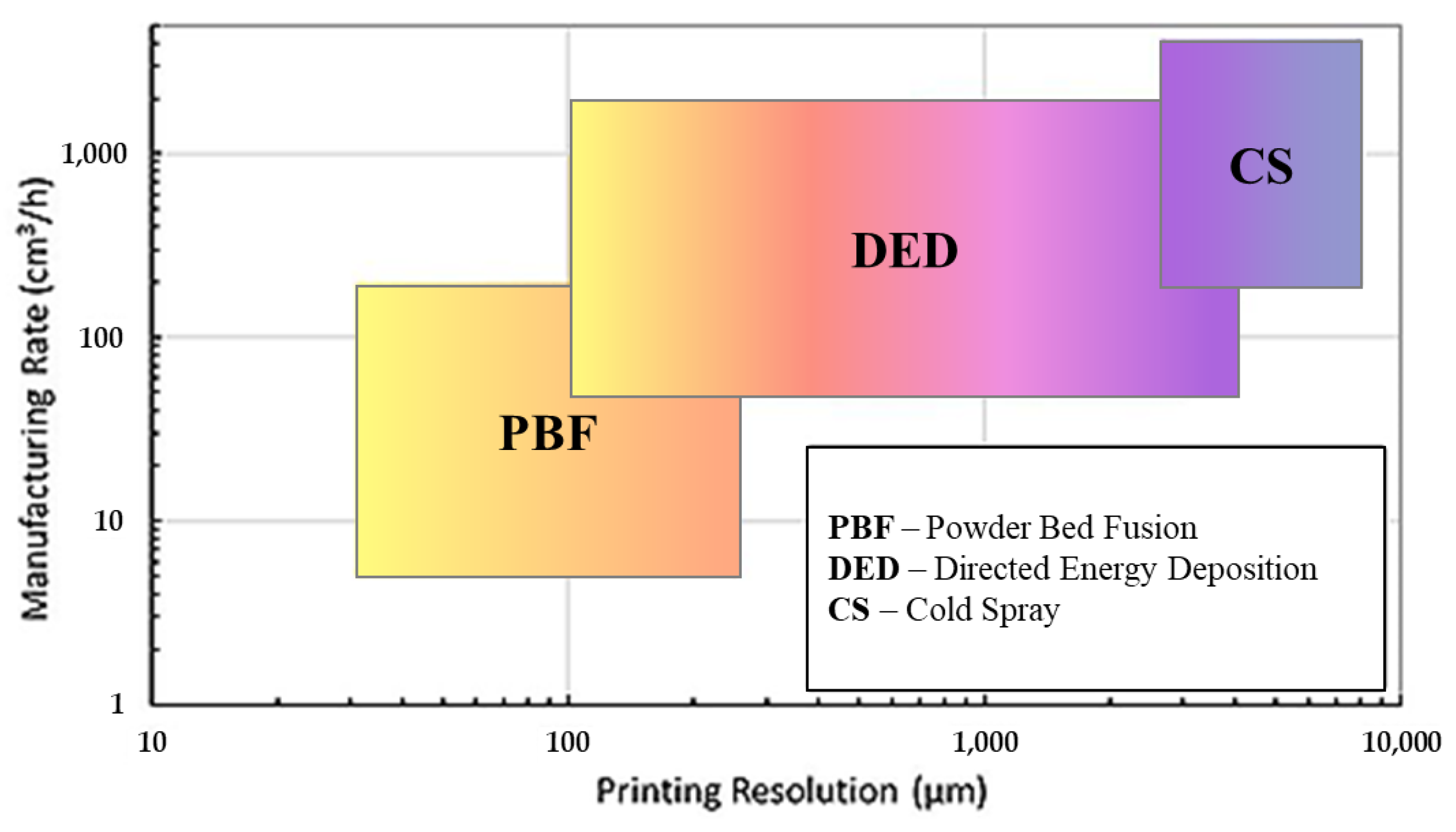

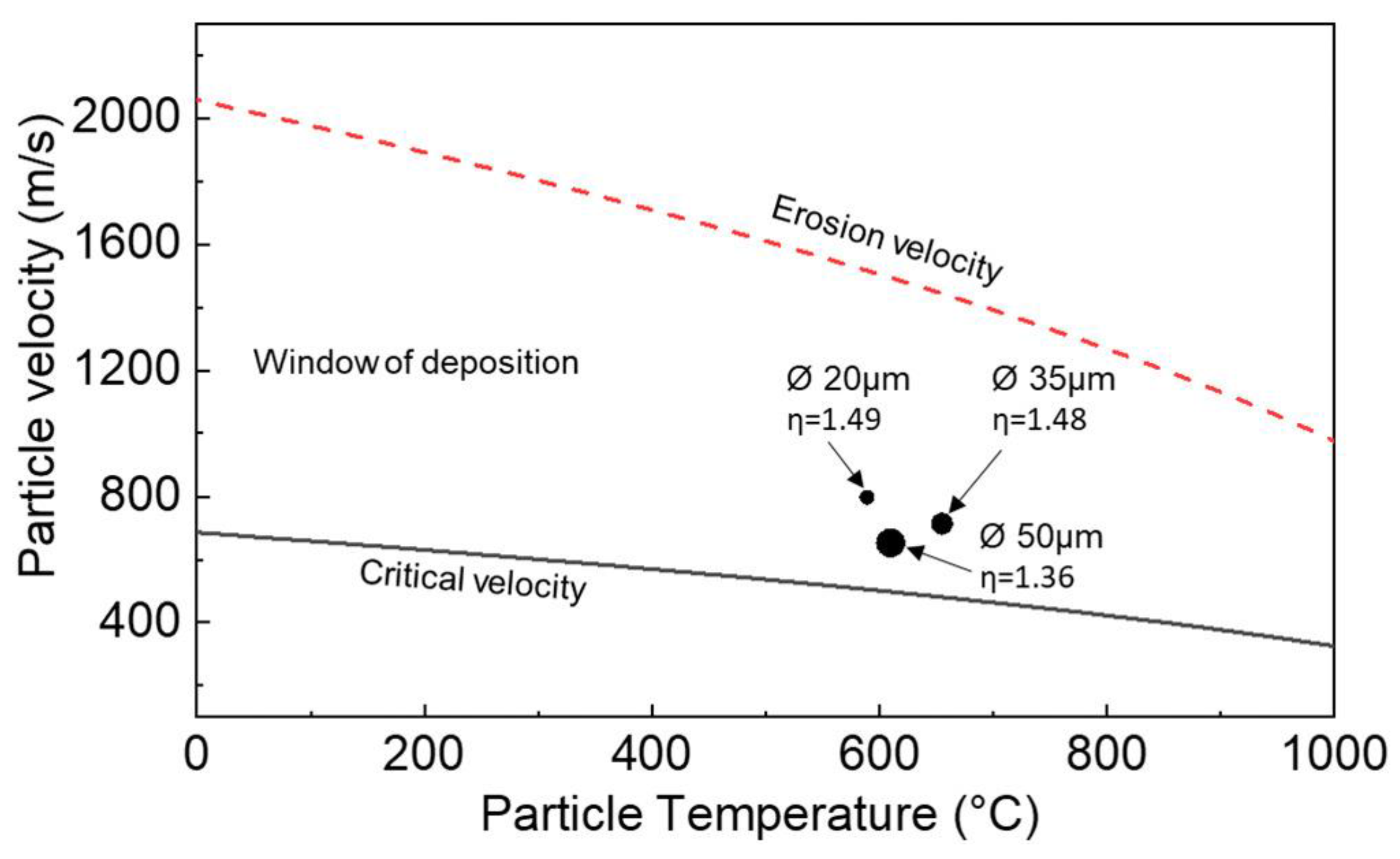

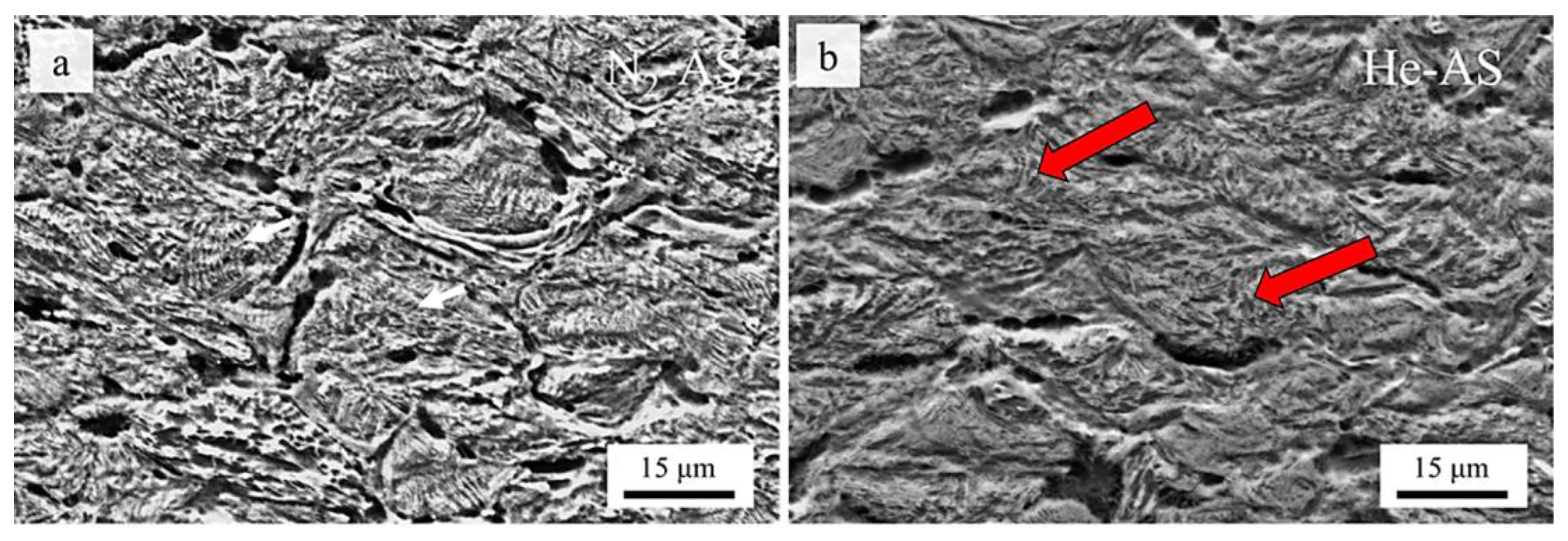

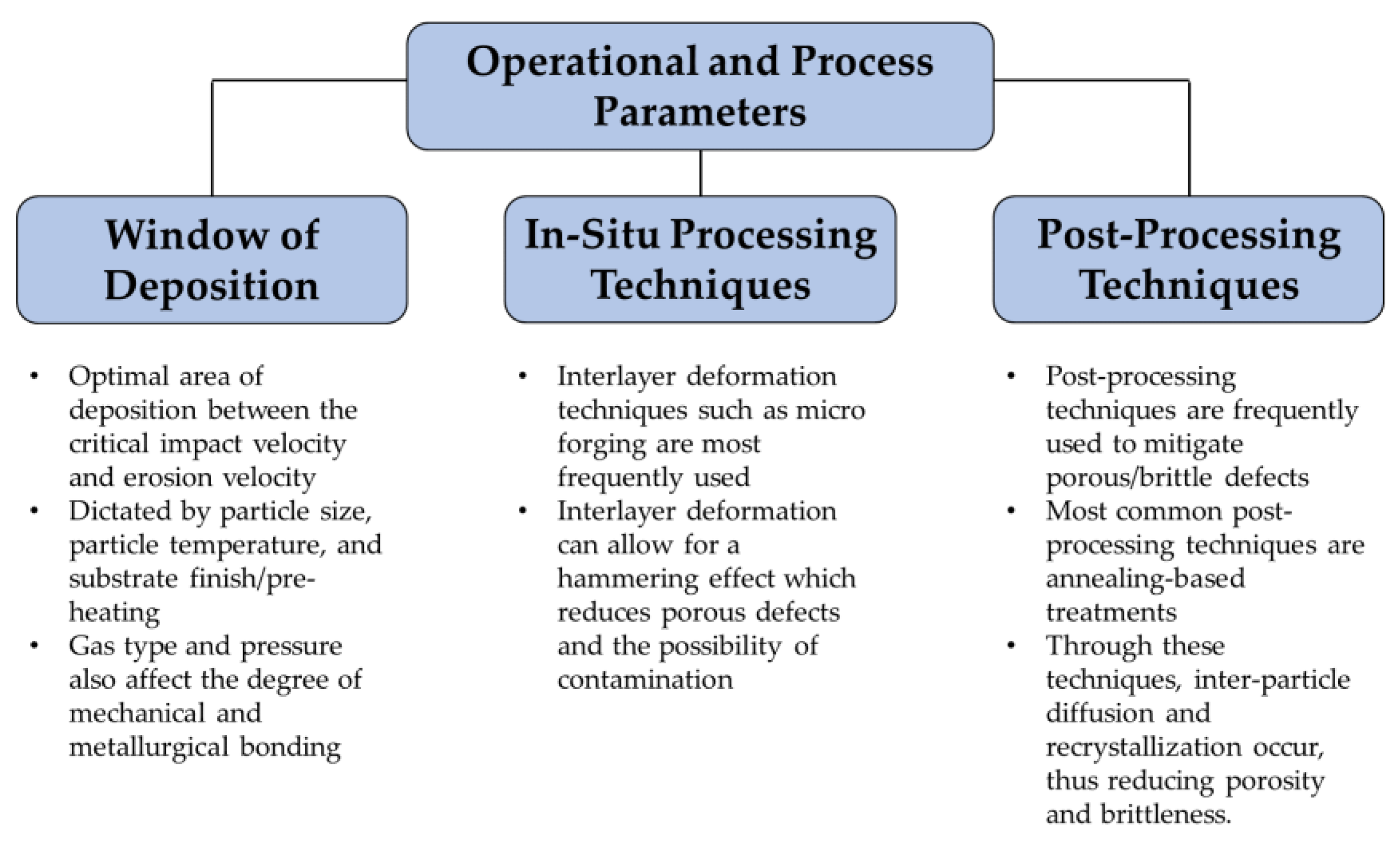



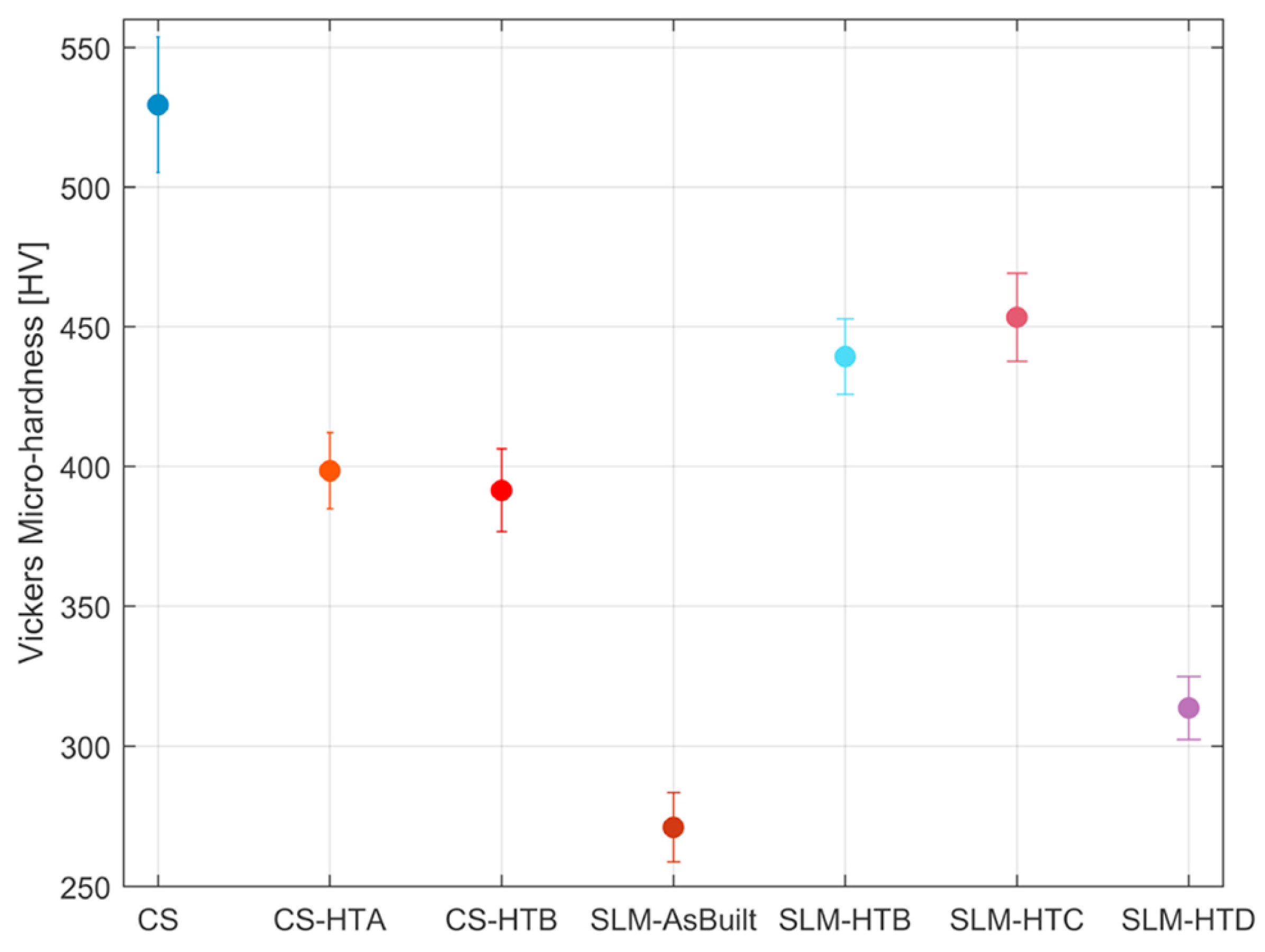

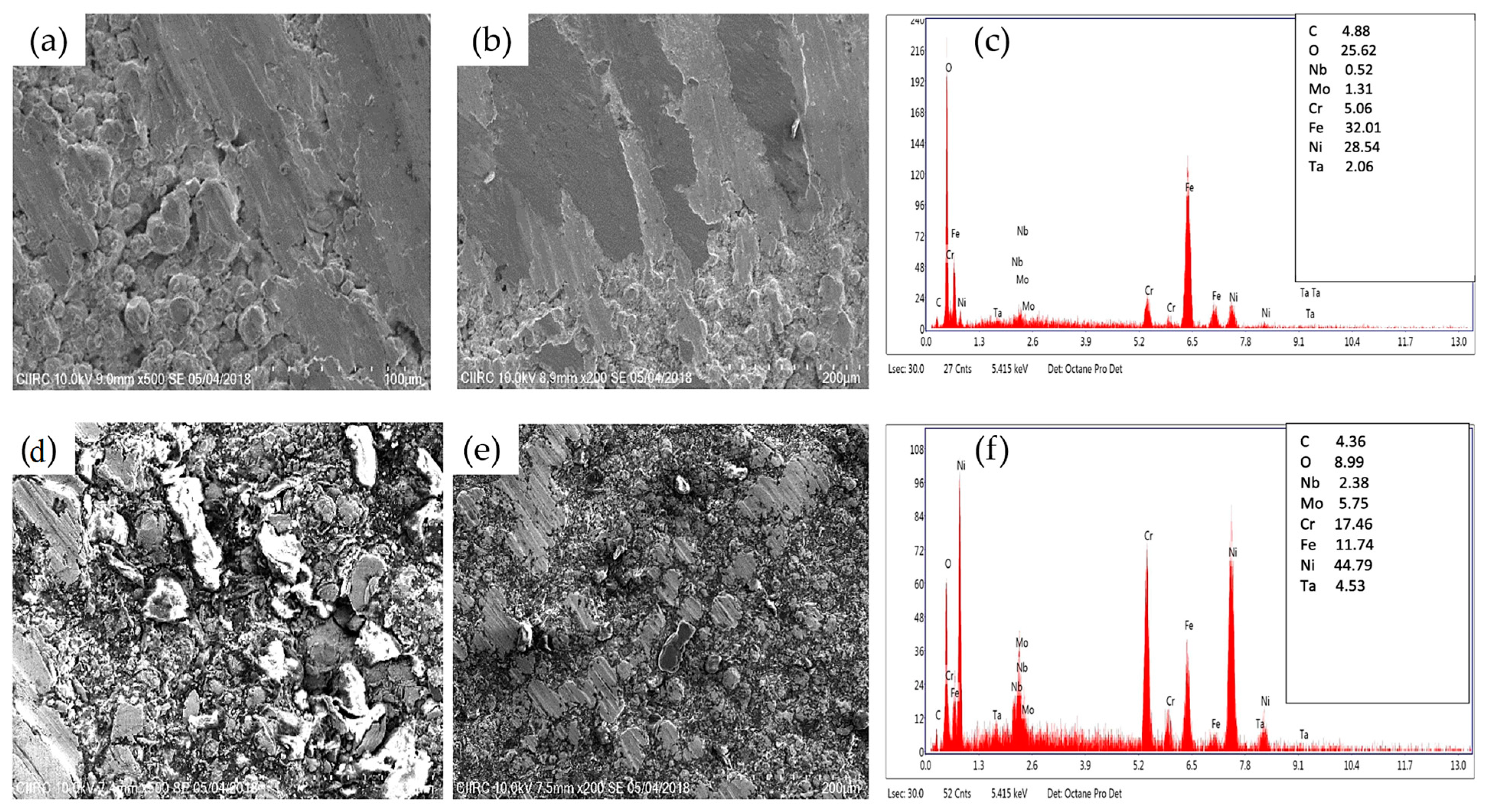
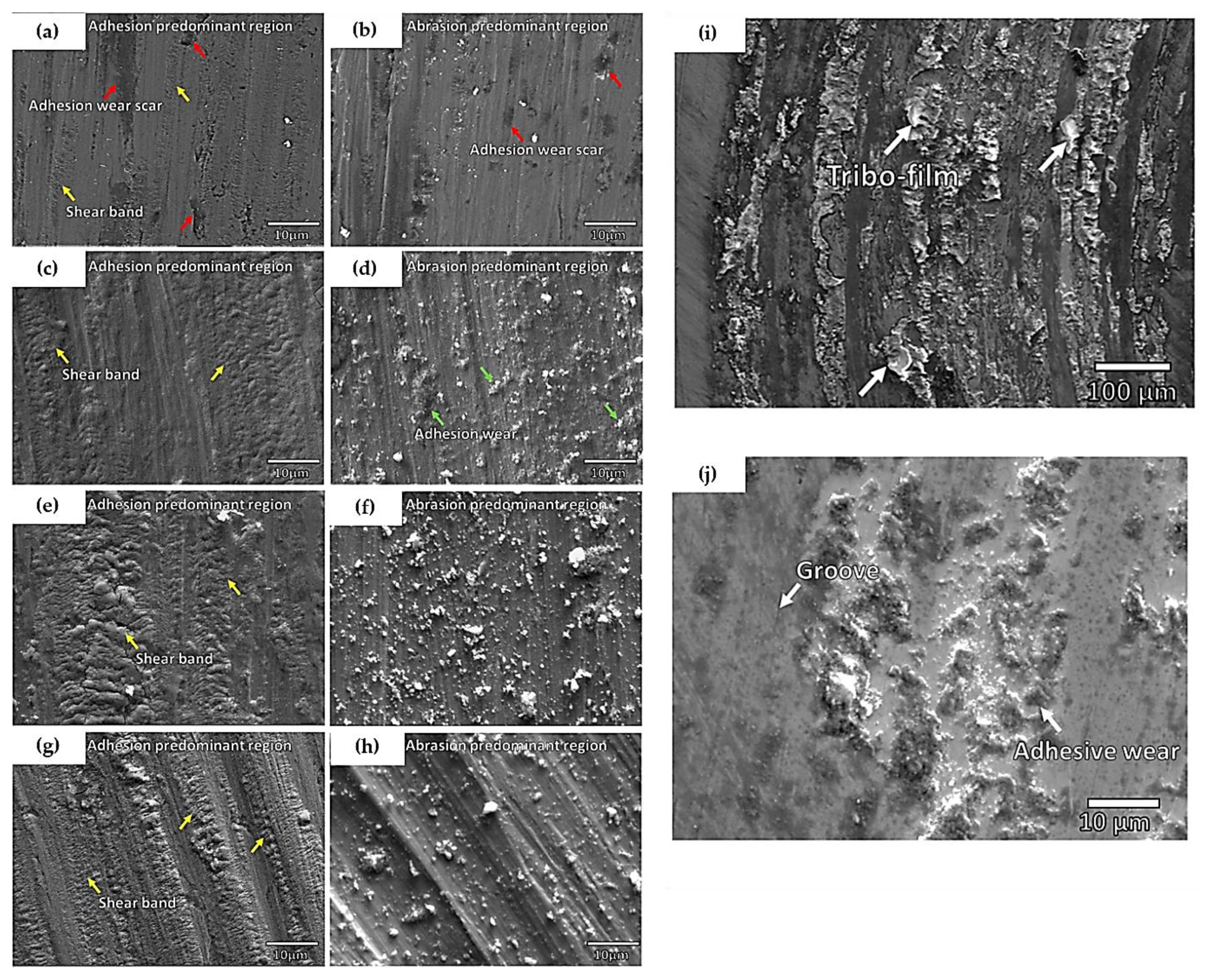
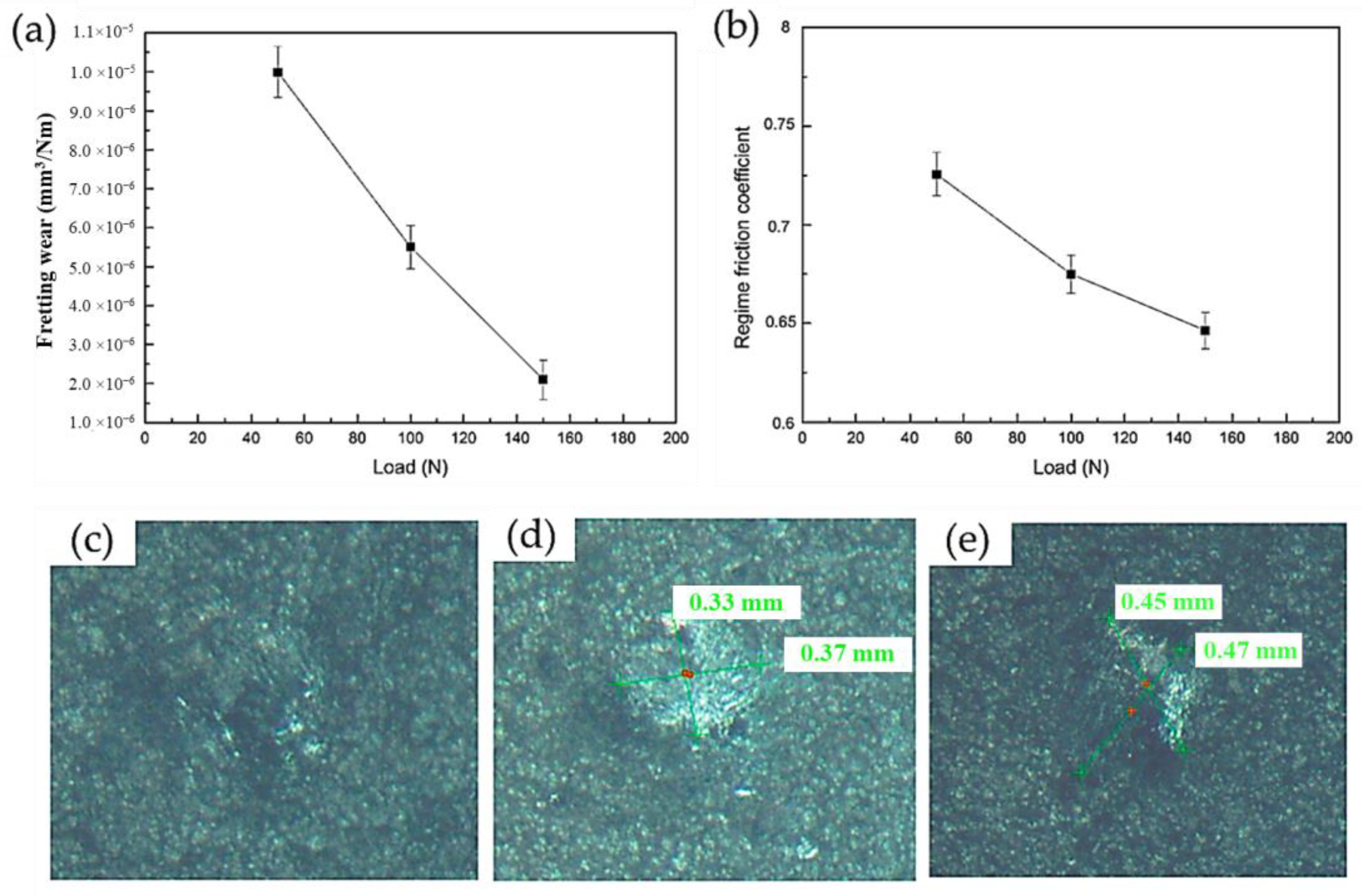
| Feedstock | Substrate | Spray Parameters | Observations | Porosity % before Post-Treatment | Porosity % after Post-Treatment | Ref. |
|---|---|---|---|---|---|---|
| IN 718 | Low-carbon steel |
|
|
|
| [90] |
| IN 718 | Al |
|
|
|
| [91] |
| IN 718 | Al |
|
|
|
| [82] |
| IN 718 | IN 718 |
|
|
| N/A | [92] |
| IN 625 | Carbon steel |
|
|
| N/A | [93] |
| IN 625 | 4130 chrome alloy steel |
|
| N/A | N/A | [65] |
| IN 718 | IN 718 |
|
|
|
| [83] |
| IN 625 | Aluminum 6061 |
|
|
| N/A | [75] |
| IN 718 | IN 718 |
|
|
|
| [94] |
| IN 625 | IN 625 |
|
|
| N/A | [95] |
| IN 718 | Aluminum |
|
|
|
| [96] |
| Samples Sprayed | Parameters | Porosity (%) | Hardness (HV) | UTS (MPa) | Elongation (%) | Reference |
|---|---|---|---|---|---|---|
| As-sprayed, 0% MF | 700 °C, 25 bar | 5.7 | 400 | 96.4 | 0.12 | [80] |
| As-sprayed, 50% MF | 700 °C, 25 bar | 0.23 | 500 | 463 | 0.48 | [80] |
| Heat-treated, 1200 °C, 6 h, 50% MF | 700 °C, 25 bar | 0.5 | 400 | 1089 | 6.17 | [80] |
| As-sprayed, He | 1000 °C, 30 bar | 0.21 | 600 | 1168 | 0.58 | [78] |
| Heat-treated, He, 990 °C, 4 h | 1000 °C, 30 bar | 0.18 | 400 | 1272 | 9.64 | [78] |
| As-sprayed, N2 | 1000 °C, 50 bar | 2.7 | NA | 277 | 0.23 | [91] |
| As-sprayed, He | 1000 °C, 20 bar | 3.4 | NA | 204 | 0.18 | [91] |
| Heat-treated, N2, 1250 °C, 1 h | 1000 °C, 50 bar | 2.0 | NA | 764 | 24.7 | [91] |
| As-sprayed | 1000 °C, 55 bar | 1.2 | 530 | 713 | 0.45 | [96] |
| Heat-treated, 1050 °C, 3 h | 1000 °C, 55 bar | 1.0 | 400 | 1260 | 8.85 | [96] |
| Heat-treated, 1200 °C, 1 h | 1000 °C, 55 bar | 1.0 | 400 | 1289 | 15 | [96] |
Disclaimer/Publisher’s Note: The statements, opinions and data contained in all publications are solely those of the individual author(s) and contributor(s) and not of MDPI and/or the editor(s). MDPI and/or the editor(s) disclaim responsibility for any injury to people or property resulting from any ideas, methods, instructions or products referred to in the content. |
© 2023 by the authors. Licensee MDPI, Basel, Switzerland. This article is an open access article distributed under the terms and conditions of the Creative Commons Attribution (CC BY) license (https://creativecommons.org/licenses/by/4.0/).
Share and Cite
Ralls, A.M.; Daroonparvar, M.; John, M.; Sikdar, S.; Menezes, P.L. Solid-State Cold Spray Additive Manufacturing of Ni-Based Superalloys: Processing–Microstructure–Property Relationships. Materials 2023, 16, 2765. https://doi.org/10.3390/ma16072765
Ralls AM, Daroonparvar M, John M, Sikdar S, Menezes PL. Solid-State Cold Spray Additive Manufacturing of Ni-Based Superalloys: Processing–Microstructure–Property Relationships. Materials. 2023; 16(7):2765. https://doi.org/10.3390/ma16072765
Chicago/Turabian StyleRalls, Alessandro M., Mohammadreza Daroonparvar, Merbin John, Soumya Sikdar, and Pradeep L. Menezes. 2023. "Solid-State Cold Spray Additive Manufacturing of Ni-Based Superalloys: Processing–Microstructure–Property Relationships" Materials 16, no. 7: 2765. https://doi.org/10.3390/ma16072765
APA StyleRalls, A. M., Daroonparvar, M., John, M., Sikdar, S., & Menezes, P. L. (2023). Solid-State Cold Spray Additive Manufacturing of Ni-Based Superalloys: Processing–Microstructure–Property Relationships. Materials, 16(7), 2765. https://doi.org/10.3390/ma16072765








